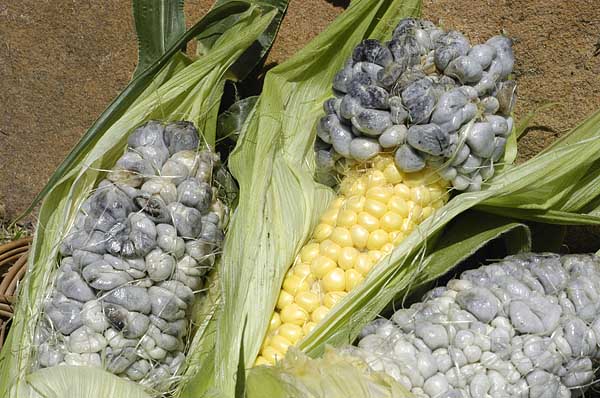 It’s hard to believe that something that’s been described by turns as gnarly, slimy and insidious-looking, as tumors filled with pustular black secretretions, as greenish white galls filled with black spores and just downright disgusting could possibly be considered a delicacy. But natives of the Southwest and Mexico have been consuming and adoring the inky black fungus that often infects corn known as huitlacoche (or, more colloquially, corn smut) since the time of the Aztecs.
It’s hard to believe that something that’s been described by turns as gnarly, slimy and insidious-looking, as tumors filled with pustular black secretretions, as greenish white galls filled with black spores and just downright disgusting could possibly be considered a delicacy. But natives of the Southwest and Mexico have been consuming and adoring the inky black fungus that often infects corn known as huitlacoche (or, more colloquially, corn smut) since the time of the Aztecs.
Don’t be fooled by its scary looks or the fact that technically you’re eating an infection: while many American farmers spend time and resources trying to irradicate Ustilago maydis (huitlacoche’s proper name) from their crops, those in the know cultivate and appreciate the fungus for its rich, earthy flavor. Huitlacoche is sometimes even called the “Mexican truffle,” for its similarity in taste to that other fungal delicacy. Huitlacoche can add an almost smoky depth and complexity to a wide variety of foods; it’s used primarily to give a little extra je-ne-sais-quoi to rellenos, enchiladas, quesadillas – basically anything you can stuff and serve with chile!
And if that weren’t enough, huitlacoche is fast approaching super-food status. Turns out the corn blight actually contains even more good stuff than the corn itself. Research shows that huitlacoche is packed with essential fatty acids and amino acids like lysine.
 But while huitlacoche grows locally, Chef Ka’ainoa says it’s almost impossible to buy it locally. “Farmers here, they see it on their corn and they just throw it out,” – a major disappointment for us locavores. Still, we can’t resist using such an awesome embodiment of the concept of letting nothing go to waste on our menu. Chef Ka’ainoa uses it to give our new vegetable-stuffed roasted poblano to add a rich, mushroomy flavor. I
But while huitlacoche grows locally, Chef Ka’ainoa says it’s almost impossible to buy it locally. “Farmers here, they see it on their corn and they just throw it out,” – a major disappointment for us locavores. Still, we can’t resist using such an awesome embodiment of the concept of letting nothing go to waste on our menu. Chef Ka’ainoa uses it to give our new vegetable-stuffed roasted poblano to add a rich, mushroomy flavor. I
f you aren’t already a huitlacoche devotee, try adding it your favorite tamale recipe. Or, if you care to be a bit more daring with your corn smut you can check out some of these creative recipes (like huitlacoche ice cream and huitlacoche pate) on the University of Illinois Crop Science website.
Or come join us at the restaurant as we give it a try for ourselves!
